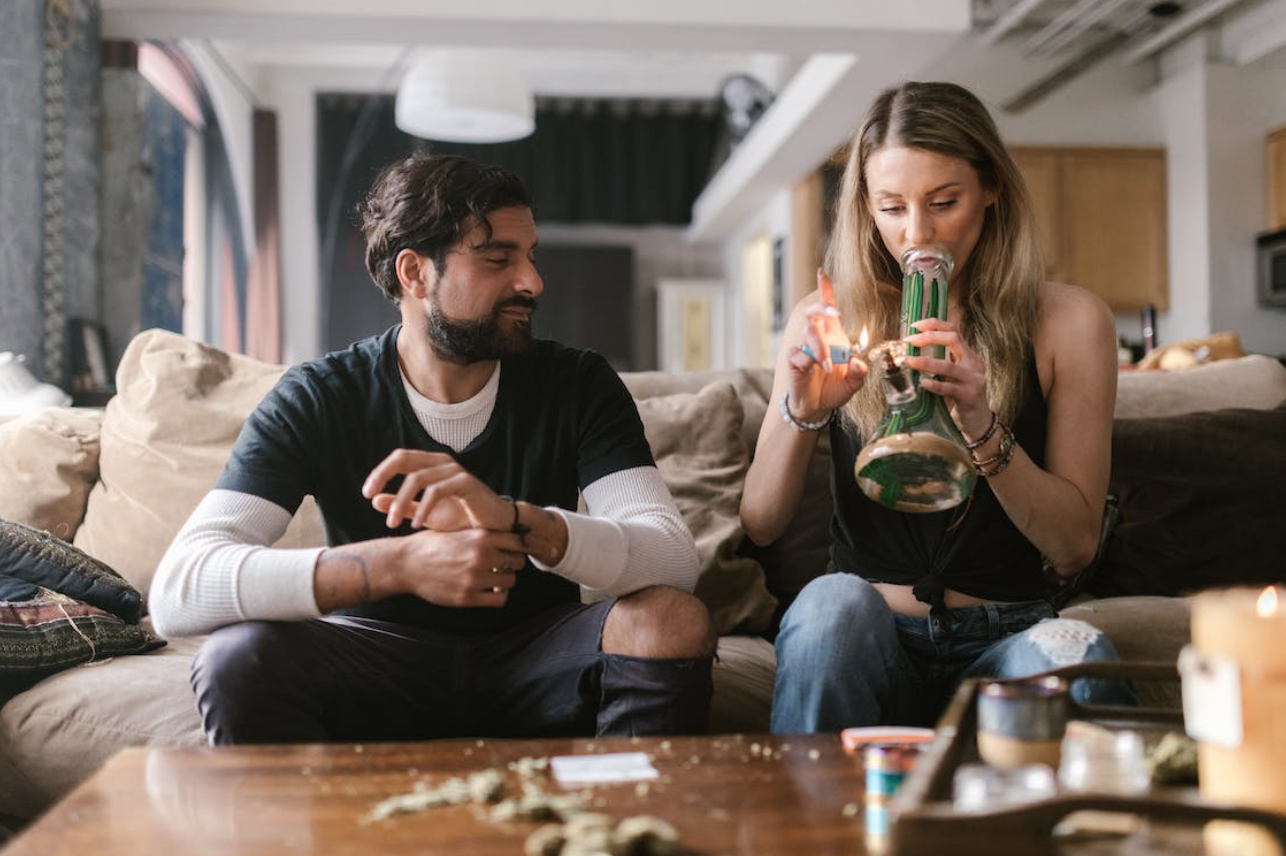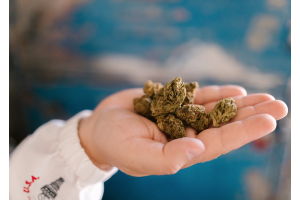Waterpipes - The Big Bong Theory

While the waterpipe had traditionally been used for tobacco for centuries, waterpipes are associated only with cannabis use.
Models for cannabis vary widely. Some are compact and portable, while most are designed for tabletops. Some models are made of silicone or ceramic. In contrast, most are made with bowls of glass or metal and bodies of acrylic or glass. Glass bodies have morphed into sculptural designs whose creation has elevated the craft into an art form. As accouterments of cannabis culture, ornate tabletop models have been nicknamed “bongs,” while pocket-size models are called “bubblers.” Whether simple craft or ornate art, whether tabletop or pocket size, the two ingredients that all models ultimately share are cannabis and water.
Waterpipes Are Way Cool
Bongs assure you that you are being kind to your lungs. Just hearing their bubbling sounds calms your senses. And when you are done, pouring the chamber’s spent water down the drain enhances your feeling of good health. When you smell its stench, you can be thankful that the stink is in the sink, not your lungs. You are doing your lungs a big favor by cleaning, cooling, and moistening the smoke. Or so you believe.
Your assumptions are only partially correct. Yes, waterpipes do cool the otherwise hot and scratchy smoke. But contrary to many smokers’ expectations, waterpipes do not moisten it. Hot and dry, smoke desiccates and irritates your mouth and throat, which makes you more susceptible to respiratory diseases. The parched air of indoor heating, which dries out your nasal passage and mouth and throat, contributes to the higher incidence of colds and flu in winter. To counteract the arid air, room humidifiers add water vapor into the air. While it is comforting to consider waterpipes as humidifiers for your mouth and throat, that analogy does not hold water.
The power of suggestion is strong. The bubbling water in the bong makes you believe that the smoke bubbles gather moisture along the route from the bowl to your mouth. Yet, chemical analysis of the smoke exiting the waterpipe has proven otherwise. The mere passage through water does not impart any steam into the smoke. You might be as high as a kite, but the smoke remains as dry as a bone.
Ashes to Ashes, Lung to LungAlthough smoke bubbles absorb no moisture from the water, the water does gather something from the smoke. The water purifies the smoke bubbles by trapping water-soluble toxins such as hydrogen cyanide, much of hydrocarbons, tar, and ash.1 There is no safe level of tar and ash in your lungs. Any minute amount is harmful. So water indeed is a health-promoting feature of all waterpipes.
You probably use lukewarm or cold water when you fill your water pipe straight from the faucet. Cold water indeed cools the smoke, while experienced waterpipe users claim that hot water traps more tar.2 If so, a dual-chambered waterpipe would be ideal, one chamber filled with hot water, the second chamber with cold. While such models exist, most waterpipes lack two chambers, so that you can resort to two other health-promoting techniques.
First, change the water in the chamber midway through each smoking session before the water loses its cleaning efficiency. Second, use non-chlorinated water. We already drink too much-chlorinated water from municipal water systems, so avoid inhaling chlorine vapors. In its most lethal form, chlorine gas devastated the Allied armies of WWI trench warfare. If you draw tap water from your sink’s faucet, filter it. Or let the water sit in an open container for
twenty-four hours, and the chlorine will evaporate.In theory, chlorine bleach intended for removing laundry stains might be effective for cleaning stained bongs. In practice, liquid chlorine bleach is noxious to inhale, caustic to handle, and leaves a lingering antiseptic odor on your bong. You’re better off not staining your bong in the first place.
Water itself will not stain your bong, so fill the chamber only with water, never with soda, juice, tea, or coffee, and contrary to the legendary beer bong, never with alcohol.Alcohol very effectively captures cannabinoids, which is why alcohol is used for making cannabis tinctures.3 That is reason enough not to fill your bong with any alcoholic beverage. Furthermore, alcohol is the most toxic of all recreational drugs.4 Further still, alcohol that is addictive when ingested by the stomach is even more addictive when inhaled by the lungs.

Testing the Waters
Now comes some unsettling news, hinted in the previous statement that alcohol captures cannabinoids. The water that filters out the undesirable components of smoke also filters out the terpenes and cannabinoids. A widely cited study published in 1993 reviewed six previous cannabis studies conducted primarily during the 1970s6, the primordial years of cannabis research. That review study concluded that much tar was captured, and so was much THC.A noteworthy study published in 1996 further challenged many popular beliefs about waterpipes. Rather than focus on THC alone, it tested the spent waters for the full range of total cannabinoids.
It found that waterpipes filtered out proportionately more cannabinoids than tar. It postulated that to compensate for lost cannabinoids, waterpipe users smoke more and inhale more tars.7 With smokers right back where they started in regard to the total intake of tars and other toxins, the potential benefit reaped from waterpipes was canceled out.8This quandary about the counterproductive ratio of captured tar to captured cannabinoids presently lacks any definitive answer and probably never will be answered. Continued exploration of the efficacy of smoking cannabis with waterpipes has hit a dead end. That 1996 study was the last of its kind. A harm reduction study published in 2015 cited the 1996 study, but it conducted no further research and cast no more light on the subject.9 Instead, research has been redirected to the technological wonder of herbal vaporizers.
That shift has yielded a deluge of studies investigating and confirming the health benefits of vaporizers over smoking. So if you were considering purchasing a waterpipe, you might consider turning to the latest generation of vaporizers instead.Alternatively, if you presently use a waterpipe, you can research to reach your conclusions. You can perform an animal experiment, the animal being you. Measure two equal quantities of herbal cannabis that meet your expectations for a single waterpipe session. Administer dosage A with your waterpipe. Wait forty-eight hours, and then administer dosage B with your hand pipe.To achieve the same relief or high as with your waterpipe,did you need to administer the full measure of dosage B with your hand pipe, or do you have some leftovers? Anything remaining was the extra amount of cannabis you needed to squander to compensate for the cannabinoids and terpenes trapped by the water in the waterpipe. That’s extra smoke that potentially sullies your lungs.
TB or Not TB?
Smoking cannabis with waterpipes adds one risk factor that has never been linked to smoking joints or hand pipes. The incidence of tuberculosis (TB) is rare among Caucasians in North America, Australia, and Great Britain but continues to be diagnosed among new immigrants from Asia and Africa. In countries of the West and especially Australia, when an immigrant household or circle of friends regularly shares cannabis in a waterpipe, a high TB infection rate occurs.10Water provides the foundation of life and an incubator for microscopic pathogens that harm larger life forms. Countless studies show that cannabis smokers suffer a higher incidence of wheezing, coughing, and spitting than nonsmokers and that such signs of ill health are precursors to respiratory illnesses. But no study has investigated what proportion of the high incidence of colds and flus might be directly attributed to waterpipes. Isolated cases of other respiratory diseases have also been traced to waterpipes, even when not shared with others. If not emptied, cleaned, and thoroughly dried after each use, the health risk in waterpipes resides in the moist environment that is conducive to breeding bacteria.Do bacteria carry from the water into the smoke, or do they find their way to the mouthpiece on their own steam? The many medical reports linking tuberculosis to waterpipes have not clearly articulated that answer. TB or not TB? That is not the question. The question is, waterpipe or no waterpipe?
Keep It Clean
If your answer is, “Yes, waterpipe,” you must be vigilant to keep it clear, dry, and clean.
Buy It Clear: Buy and use only a waterpipe that is transparent. You need to see just how clean or dirty are its inside walls. Leave behind the psychedelic-colored bongs to decorate the smoke shop, not your home.
Store It Dry: Rinse and thoroughly dry the entire assembly after each use. Otherwise, a moist waterpipe can become a breeding ground for mold and bacteria.
Keep It Clean: To thoroughly clean the entire glass pipe, use either isopropyl alcohol (rubbing alcohol) or ethanol (ethyl alcohol). For cleaning purposes, the two solvents are interchangeable. Ethanol will get you drunk if you drink them, while iso alcohol will make you sick. But iso alcohol is safer to handle and dispose of than ethanol. Salt does not dissolve in alcohol, so to serve as an abrasive for cleaning tar, add some coarse-grain salt to the solvent, and shake the salty solvent inside your bong. If you rinse and dry it after each use, you can consider delaying its thorough cleaning. Delay until every other use? Or every ten? There is no user manual to consult for this. The choice is yours.
Clean, Rinse, Dry, and Repeat
If you share your treasured waterpipe with anyone other than your lover, always sanitize the mouthpiece with alcohol wipes before passing the bong to your smoking companion. Then wipe off any alcohol from the mouthpiece. Your waterpipe experience will not be enhanced by the antiseptic smell of a doctor’s office. If all these preventive measures for cleaning your waterpipe have not discouraged you from enjoying your pipe, please do Clean, Rinse, Dry, and Repeat as needed. Just be aware that if you’re a recreational smoker and want to use your bong before it’s completely dry, you’re probably smoking too much.
Written and Published by Mathew Braunstein in Weed World Magazine issue 160
Featured Image: Pexels
Image: Pexels












Validate your login